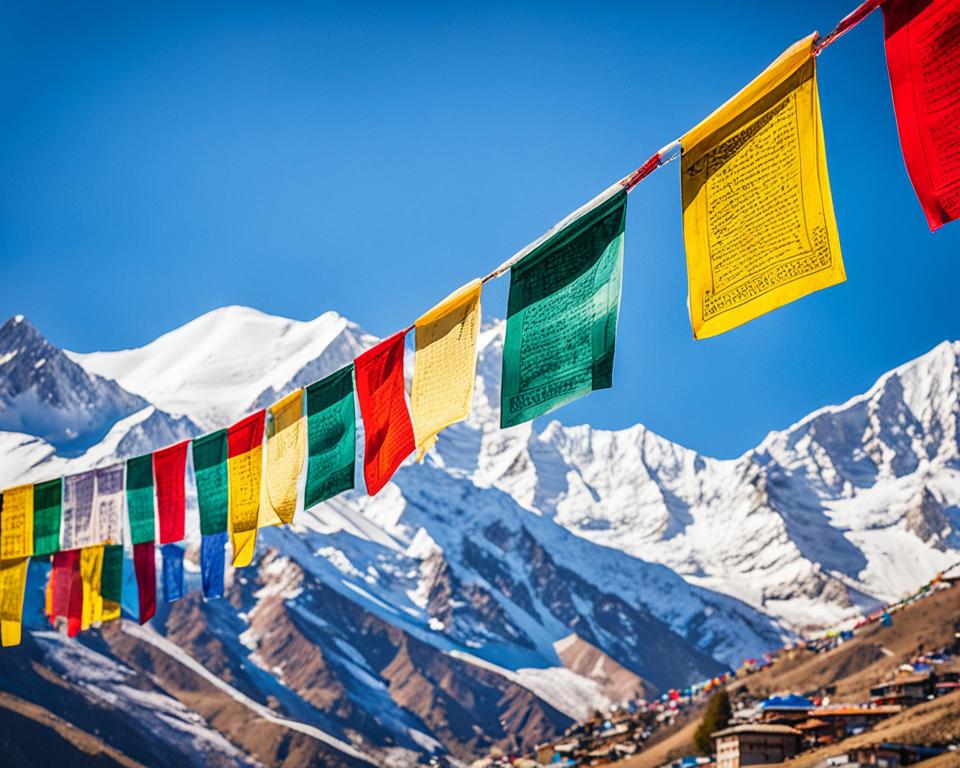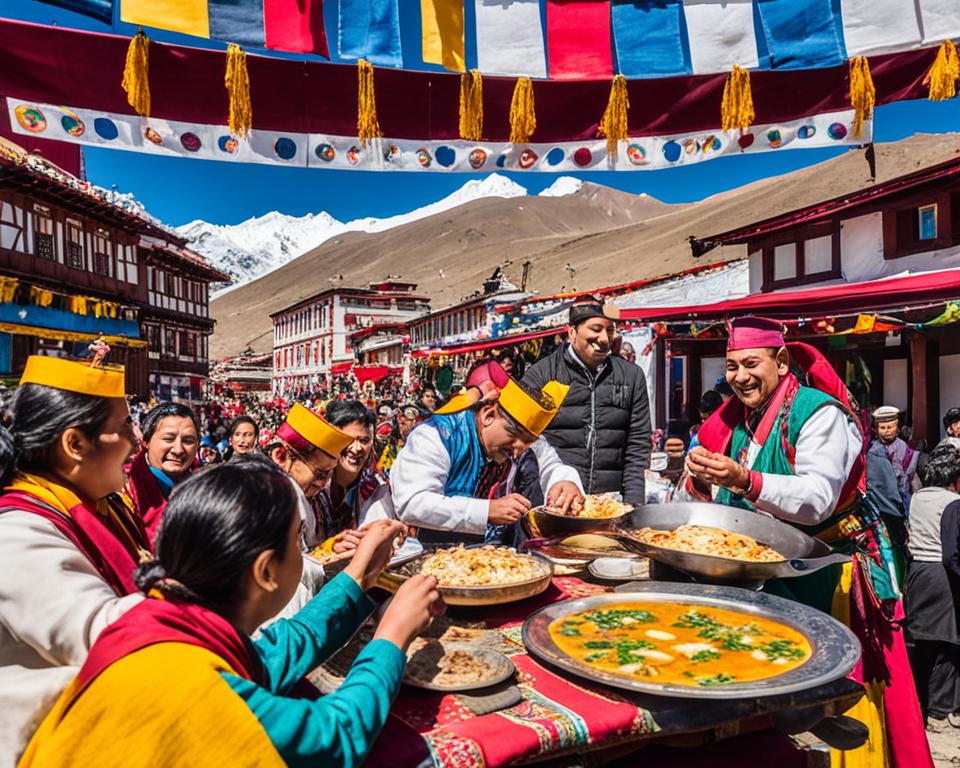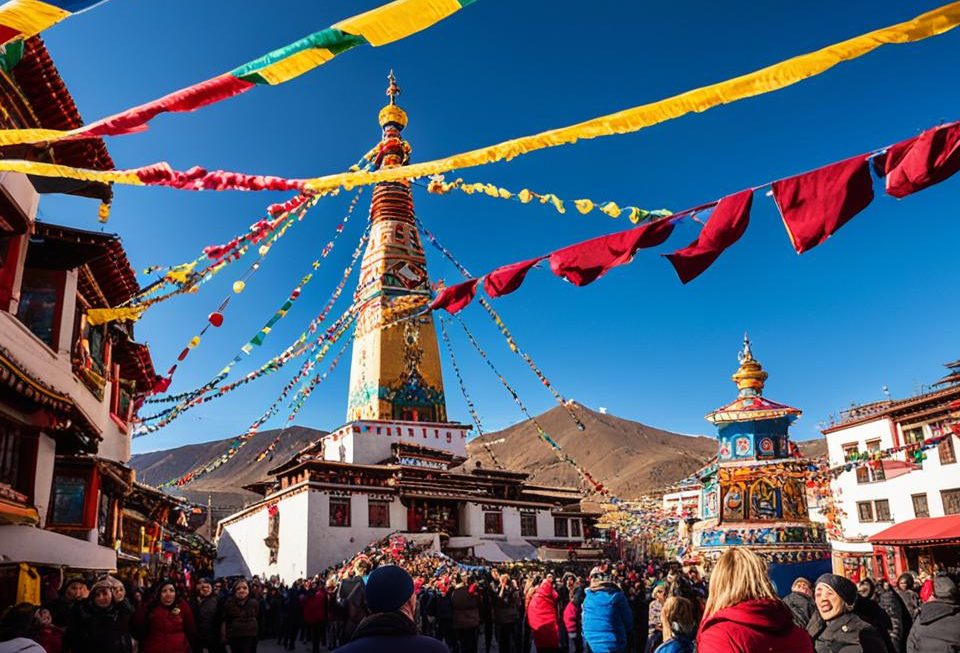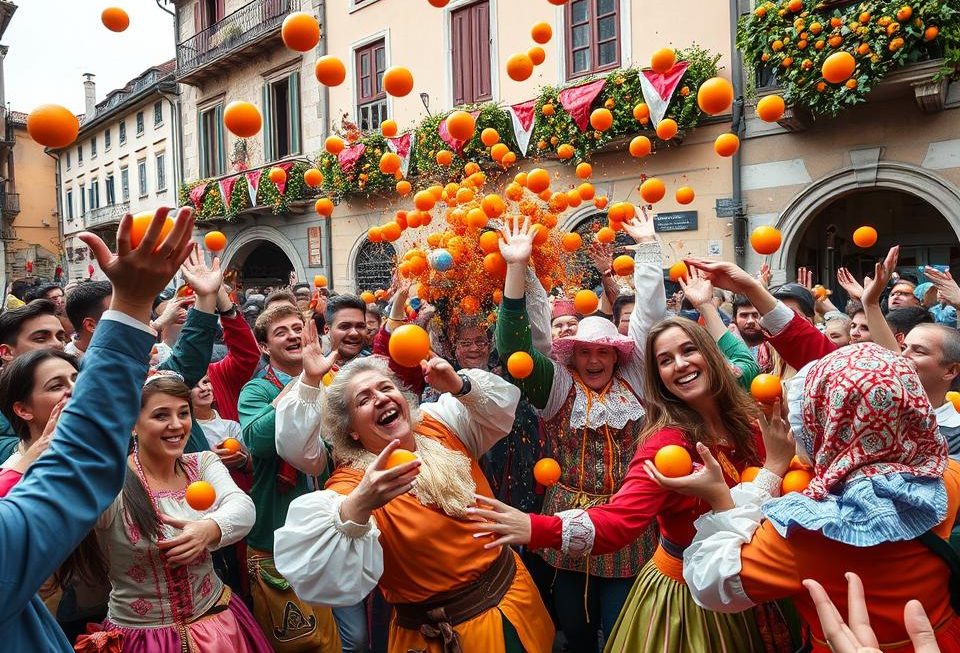Sonam Lhosar, the Tibetan New Year, is a lively and culturally deep celebration. It’s important to Tibetans all over the world. This festival kicks off the new year on the Tibetan lunar calendar. It combines old traditions, spiritual acts, and fun festivities.
The Sonam Lhosar celebration shows the strength and richness of Tibetan culture. It’s kept alive by Tibetans in their homeland and around the world.
Read interesting things at : honjo-guruguru
Key Takeaways
- Sonam Lhosar is the Tibetan New Year celebration, marking the start of a new year on the Tibetan lunar calendar.
- The festival is deeply rooted in Tibetan cultural and spiritual traditions, blending ancient practices with contemporary celebrations.
- Sonam Lhosar is observed by Tibetans both in their homeland and across the global diaspora, preserving and sharing their unique cultural heritage.
- The celebrations feature a wide range of traditions, including cleaning and decorating homes, baking traditional dishes, and participating in monastic and community events.
- Sonam Lhosar is a testament to the resilience and vibrancy of Tibetan culture, as it continues to thrive and evolve over time.
Understanding Sonam Lhosar
Sonam Lhosar, also known as Losar, is the top tibetan new year event in the Tibetan calendar. It means “Auspicious New Year” in Tibetan. This festival is all about getting blessings, good luck, and starting fresh.
This lively buddhist festival is a big part of tibetan culture and tibetan traditions. It goes way back to before Buddhism came to Tibet.
Meaning and Significance
The sonam lhosar festival is very important to Tibetans everywhere. It’s a time to look back, celebrate now, and look forward with hope and new beginnings. The festival’s traditions and rituals are closely linked to Tibetan Buddhism.
They focus on values like kindness, peace, and the cycle of life.
Historical Origins
The roots of sonam lhosar go back to before Buddhism in Tibet. It used to mark the start of a new year and the season change. As Buddhism spread, the festival added Buddhist elements.
“The celebration of Sonam Lhosar is a testament to the resilience and adaptability of Tibetan culture, seamlessly integrating ancient traditions with the spiritual wisdom of Buddhism.”
Traditions and Rituals
Sonam Lhosar, the Tibetan New Year, is filled with traditional customs and spiritual rituals. These include cleaning and decorating homes, offering incense, and saying prayers. Each part of the celebration is important for Tibetans.
One key tradition is cleaning and decorating homes. Families clean and decorate their spaces with symbols and colors. This brings in the new year with a clean and happy home.
Offering incense and prayers is also a big part of the celebration. Tibetans light incense sticks and say mantras and sutras. They ask for blessings and good luck in the next year. These prayers happen in homes and monasteries, showing a strong spiritual bond to the Buddhist festival.
During Sonam Lhosar, Tibetans also share symbolic gifts. They give out scarves (khatags), food, and sweets. These gifts show kindness and friendship, which is a big part of the celebration.
“Sonam Lhosar is a time for Tibetans to come together, honor their rich cultural heritage, and seek blessings for the year ahead. Each ritual and tradition holds profound meaning, connecting us to our roots and our faith.”
Preparing for Sonam Lhosar
As Sonam Lhosar, the Tibetan new year, nears, families start getting ready. They clean and decorate their homes. This shows the end of the old and the start of the new.
Cleaning and Decorating Homes
Tibetan homes get a deep clean before Sonam Lhosar. This cleaning purifies the space. It makes it ready for Tibetan traditions and Tibetan culture.
They scrub floors, dust surfaces, and polish windows. Their homes shine and look new.
Decorations are key for Sonam Lhosar. Homes are filled with prayer flags, thangka paintings, and Tibetan knots. The air smells of juniper incense and lights from butter lamps brighten everything.
Baking Traditional Dishes
The smell of traditional Tibetan food fills the air as Sonam Lhosar approaches. Families work together in the kitchen. They make momos and changkopa, Tibetan bread.
These dishes are a big part of the Losar celebrations. They feed both the body and spirit.
Preparing these dishes keeps the tradition alive. It also brings families closer together. They enjoy making these meals together.
Monastic Celebrations
Sonam Lhosar, the Tibetan New Year, is very important for Tibetan Buddhist monasteries. It’s filled with traditions, like the creation of butter sculptures. These are made by skilled artisans as offerings and to show deep devotion.
Butter sculptures are more than just decorations. They are detailed artworks that show the deep Tibetan traditions and the spirit of the Buddhist festival. Making these sculptures takes a lot of work. Artists shape and mold butter into designs like deities, animals, or scenes from Tibetan stories.
The butter sculptures are eagerly awaited during Sonam Lhosar. Monks and followers come together to see them. They are amazed by the beauty and the effort put into these short-lived art pieces.
The butter sculptures are seen as offerings. They stand for purity, the fleeting nature of life, and the commitment of the Tibetan Buddhist people. As the festival goes on, these detailed sculptures will melt away. This reminds us of how short-lived everything is and the need to enjoy the now.
“The unveiling of the butter sculptures is a moment of pure awe and reverence, as the Tibetan Buddhist community comes together to celebrate the rich tapestry of their cultural heritage.”
Sonam Lhosar Festivities
The Sonam Lhosar festivities bring Tibetan families together. They celebrate their rich tibetan culture and enjoy many cultural performances. These celebrations are a key part of the losar celebrations. They mark the Tibetan New Year with joy and tradition.
Family Gatherings
Family gatherings are at the center of Sonam Lhosar. Families look forward to this time to reunite and share meals. They exchange gifts filled with love. The air is filled with the smell of traditional dishes.
Elders share their wisdom with the young. This is a time to learn about heritage.
Cultural Performances
The festivities also feature vibrant cultural performances. These have been passed down for generations. They include mesmerizing dances and musical performances.
These events celebrate the art of the Tibetan people. The audience sees colorful costumes and rhythmic beats. They experience the essence of Tibetan culture through these performances.
| Celebration | Description | Significance |
|---|---|---|
| Family Gatherings | Tibetan families come together to share meals, exchange gifts, and connect with their roots. | Strengthening family bonds and passing down cultural traditions. |
| Cultural Performances | Showcasing traditional Tibetan dances, music, and theatrical presentations. | Celebrating the artistic and cultural heritage of the Tibetan people. |
“The Sonam Lhosar festivities are a time when the Tibetan community comes together to honor their rich cultural heritage and create lasting memories.”
The Sonam Lhosar celebrations show the strong tibetan culture and the bond of family gatherings. Through cultural performances, the Tibetan people keep their traditions alive. They share their art with the world.
Tibetan New Year in Exile
The Tibetan diaspora finds special meaning in celebrating Sonam Lhosar. Despite political changes and being away from home, Tibetans keep their traditions alive. They make sure to celebrate Losar all over the world.
Tibetan communities around the world have created places to celebrate their heritage. They gather in monasteries, community centers, and even at home. This way, the tibetan diaspora keeps the spirit of Sonam Lhosar going, even without their old home.
“The celebration of Sonam Lhosar is a testament to the resilience and determination of the Tibetan people. It is a deeply meaningful way for us to stay connected to our roots and pass on our customs to future generations.”
The Losar celebrations in exile show how much the Tibetan community values its heritage. They celebrate with performances, rituals, and sharing traditional recipes. This keeps the spirit of Sonam Lhosar alive, even when things are tough.
Even as they live in exile, the Tibetan people hold Sonam Lhosar dear. It connects them to their past and brings them together. It shows how Tibetan culture can adapt and keep thriving, no matter what.
Sonam Lhosar Across the World
The vibrant Tibetan diaspora has spread the traditions of Sonam Lhosar, the Tibetan New Year, worldwide. Communities in India, Nepal, North America, and Europe celebrate these losar celebrations. They keep their cultural heritage alive and help Tibetans in exile feel connected to their roots.
Tibetans living outside Tibet see Sonam Lhosar as a key event. It helps them preserve traditions for the next generation. These festivals are a bridge to Tibet’s cultural heritage. They bring Tibetans in exile closer together, giving them a sense of unity and identity.
Celebrations in the Diaspora
Worldwide, Tibetans unite to celebrate Sonam Lhosar with traditional rituals and activities. They enjoy colorful parades, cultural shows, and traditional foods. These losar celebrations are a lively way to show Tibetan identity and strength.
| Location | Sonam Lhosar Celebrations |
|---|---|
| Dharamshala, India | Elaborate monastery celebrations, traditional dances, and the unveiling of intricate butter sculptures. |
| New York City, USA | Lively street festivals, Tibetan cultural performances, and the distribution of traditional Tibetan sweets. |
| London, UK | Gatherings in Tibetan community centers, sharing of Tibetan cuisine, and the lighting of butter lamps. |
The Sonam Lhosar celebrations in the Tibetan diaspora keep Tibet’s culture alive. They also build a strong sense of community and identity among Tibetans abroad.
Buddhist Rituals and Ceremonies
At the heart of Sonam Lhosar celebrations are the deeply spiritual and ritualistic practices of Tibetan Buddhism. This ancient faith is key to the Tibetan New Year festivities. Monks and devotees take part in prayer ceremonies and monastic rituals filled with Tibetan traditions.
The Sonam Lhosar celebration includes the unveiling of intricate butter sculptures by monks. These vibrant artworks often show deities, symbols, or scenes from Tibetan myths. They are carefully made and then shown to the public.
The Buddhist festival also has the chanting of sacred mantras and sutras. Traditional ceremonial dances are performed by monks. These acts honor the Tibetan New Year and help the Tibetan people connect with their cultural heritage and beliefs.
During Sonam Lhosar, the Tibetan Buddhist faith is a strong bond. It brings the community together, showing their cultural and spiritual identity.
Symbolic Offerings and Practices
Sonam Lhosar, the Tibetan New Year, is filled with symbolic offerings and practices. These traditions are part of the tibetan traditions and buddhist festival culture. They connect people with the divine and bring the community together.
Burning Incense and Prayer Flags
Burning incense is a key part of Sonam Lhosar. The smoke carries prayers and blessings to the heavens. It purifies the environment and helps with spiritual well-being.
Colorful prayer flags are also everywhere. They spread the devotees’ prayers and wishes across the world.

These symbolic offerings and practices are more than just pretty. They are important in Tibetan Buddhism. The incense smoke and the prayer flags remind us of our connection to everything. They encourage mindfulness, compassion, and living in harmony with nature.
“The burning of incense and the display of prayer flags are not just rituals, but rather a way to connect with the divine and create a sense of unity within the Tibetan community.”
During Sonam Lhosar, these symbolic offerings and practices are key. They help keep the tibetan traditions alive. They also honor the buddhist festival at the heart of this cultural event.
Unique Tibetan Traditions
Sonam Lhosar, the Tibetan New Year, is filled with unique traditions. Each one has its own special meaning. These traditions make the festival vibrant and interesting. They keep the spirit of Tibetan culture and Tibetan traditions alive.
One special part of Sonam Lhosar is making butter sculptures. Artists work hard to create these beautiful pieces. They often show religious figures, lucky symbols, or scenes from Tibetan stories. People look forward to seeing these unique celebrations.
- The making of butter sculptures is a key tradition. Each design and detail has a special meaning in Tibetan Buddhism.
- These sculptures are thought to bring blessings and good luck. They are seen as offerings and reminders of life’s fleeting nature.
Traditional Tibetan dances are another big part of Sonam Lhosar. Dancers wear colorful costumes and masks. They dance to tell stories of Tibetan history, myths, and beliefs. These dances show the deep Tibetan traditions that have been passed down for years.
“The traditions and rituals of Sonam Lhosar are not just cultural practices. They are a way to keep the essence of Tibetan identity alive and connect with the sacred in daily life.”
The unique celebrations of Sonam Lhosar show the lasting Tibetan culture. They show how it can move and inspire people all over the world.
Preserving Cultural Heritage
The celebration of Sonam Lhosar, the Tibetan New Year, shows the strong effort to preserve Tibetan cultural heritage. It’s about passing down customs, rituals, and traditions from one generation to the next. This keeps the legacy of this important festival alive.
Passing Down Customs
The Tibetan diaspora has spread around the world but still holds on to its rich cultural traditions. Families, groups, and religious organizations work hard to pass down the intricate customs of Sonam Lhosar. This keeps the younger generations connected to their Tibetan roots.
They prepare traditional Tibetan dishes and perform vibrant cultural shows for the festival. Sonam Lhosar’s rituals and practices are carefully kept alive in the diaspora. This effort to preserve cultural heritage keeps the Tibetan New Year’s spirit alive, even when faced with displacement.
“The celebration of Sonam Lhosar is not just a momentary event, but a living, breathing part of our cultural identity. By passing these traditions down to the younger generations, we ensure that the Tibetan spirit will continue to thrive, no matter where we may roam.”
The preservation of Sonam Lhosar and its customs brings Tibetans together worldwide. It’s a way to pass down the rich traditions that make up their cultural heritage.
Sonam Lhosar Celebrations Today
Tibetan culture is changing, and so are the losar celebrations. The core of tibetan culture and the buddhist festival stays strong. But, the Sonam Lhosar festivities now include new ideas and modern ways to reach Tibetans everywhere.
Now, Tibetans use technology and social media to celebrate Sonam Lhosar. They share photos, videos, and messages online. This lets Tibetans join in, no matter where they are.
In cities, Sonam Lhosar has become more lively. You’ll find street performances, market stalls, and community events. These events mix traditional dances and music with modern styles and ways to engage with the audience.
But, the spiritual and ritual parts of Sonam Lhosar are still key. Monasteries host sacred ceremonies and unveil butter sculptures. These traditions keep the deep bond between tibetan culture and the losar celebrations alive.

In the 21st century, Sonam Lhosar has changed to keep old customs and new ways in balance. This balance keeps tibetan culture and the buddhist festival alive for today’s and tomorrow’s Tibetans.
| Traditional Practices | Modern Adaptations |
|---|---|
| Spiritual rituals and ceremonies | Incorporation of technology and social media |
| Monastic butter sculpture unveiling | Vibrant street performances and market stalls |
| Family gatherings and cultural performances | Virtual celebrations and online community events |
Blending Ancient and Modern
Tibetan traditions show how well they can change and grow. They mix contemporary practices into the festivities for the Tibetan New Year, called Sonam Lhosar. As Tibetans live in today’s world, their ancient culture keeps going strong. Keeping the preservation of cultural heritage is key.
The modern Sonam Lhosar celebration is unique because it adds new things without losing its old ways. It uses digital tech and global performances. This keeps the Tibetan traditions alive for young people and the world to see.
Evolving Festivities
Even though Sonam Lhosar keeps its core rituals, it has added contemporary practices for today’s needs. It uses social media for events and brings in global culture. This shows how Tibetan culture can change and stay strong.
- Using digital tech to help plan and share Sonam Lhosar events
- Adding global art to traditional Tibetan culture
- Changing traditional foods and customs for everyone
By doing this, Tibetans keep their heritage alive and fit for today. Their celebrations are now lively and welcoming to all. They celebrate the past and look forward to the future with Sonam Lhosar.
The Significance of Sonam Lhosar
Sonam Lhosar, the Tibetan New Year, is a big deal for Tibetans everywhere. It connects the past and present. It reminds us of the Tibetan people’s strength, identity, and spirit.
This celebration is more than just fun. It’s a tradition that shows the deep values of Tibetan Buddhism. People come together, celebrate, and keep their culture alive.
Sonam Lhosar is also a symbol of the Tibetan people’s strength. For those outside Tibet, it shows their traditions are still alive. It’s a sign of their resilience and hope.



